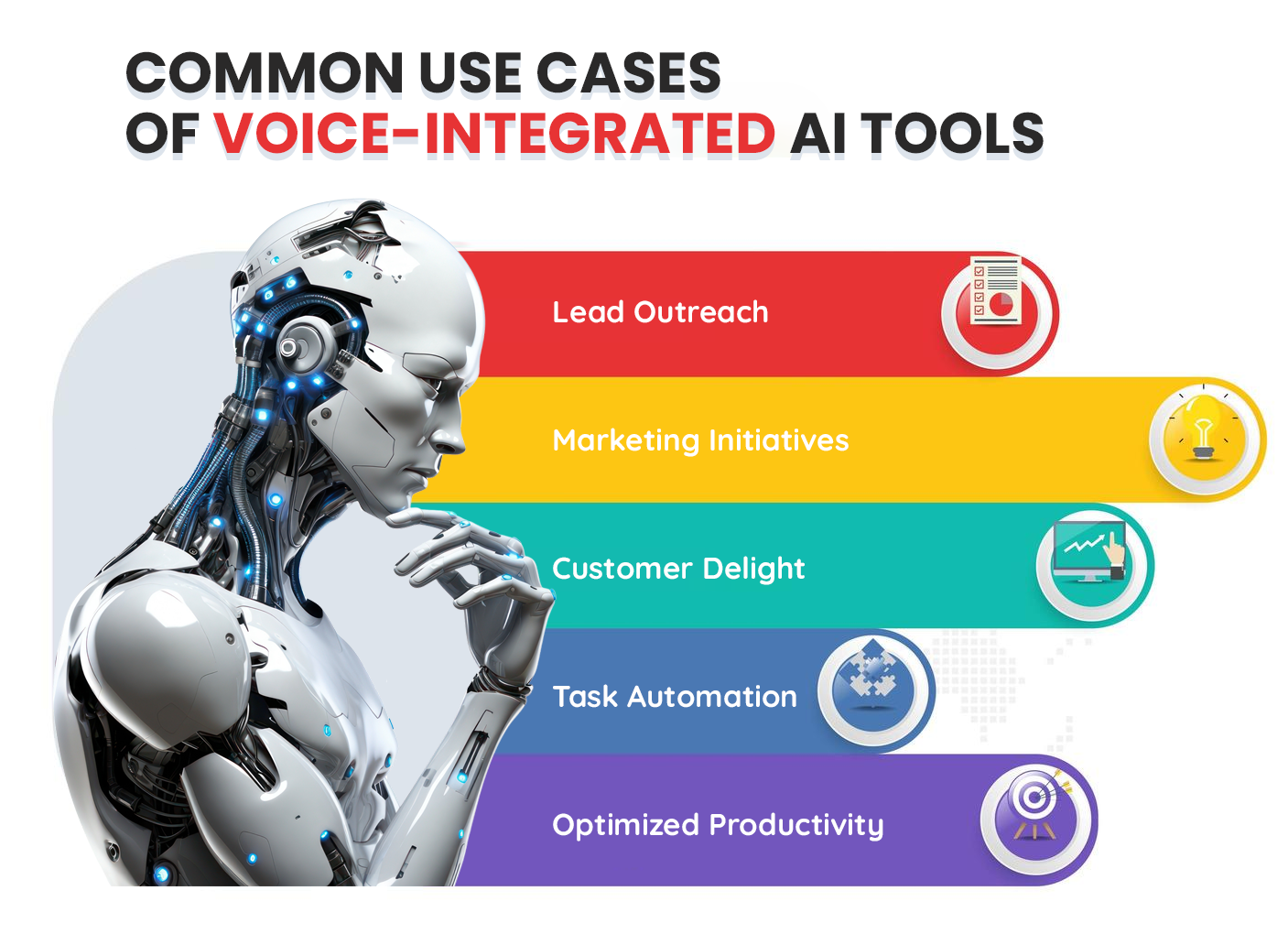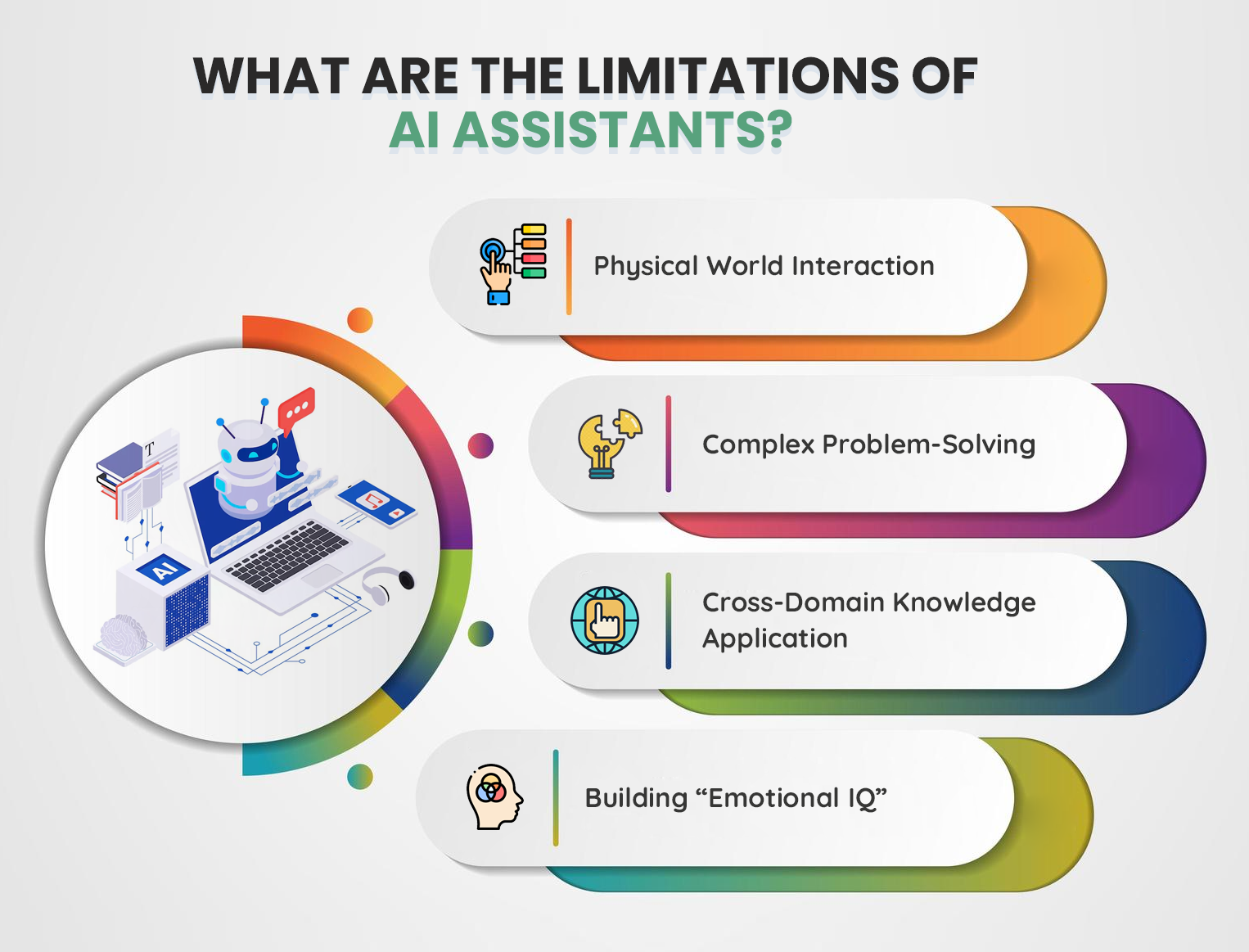
Adapting Websites for Voice Search and AI Assistants
We’ve all seen how Alexas, Google Assistants, and Siris have made AI interaction more fun and engaging. But that’s just a drop in the bucket of what AI voice assistants can achieve once we unlock their extensive range of capabilities.
Voice-activated AI assistants are transforming how we interact with technology. These intelligent virtual assistants use AI and NLP to understand spoken instructions and carry them out in a humanized manner. By using personal AI assistants, teams can response to queries, set reminders, control smart devices, and achieve real-time collaboration. Truly, the potential to grow and achieve digital transformation is endless.
This guide takes a deeper look at how AI voice assistants are reshaping the current digital landscape; exploring top use cases, benefits, and potential limitations of integrating voice-based assistants into your core operations.
Buckle up!

# AI Voice Assistants – What’s The Purpose?
Voice assistants like Amazon Alexa and Siri are popular due to their accessibility and convenience. They are valuable tools in our daily lives, making tasks easier and providing quick solutions. However, they play an even central role in modern enterprises, enabling hands-free searches, message dictation, and access to real-time information.
Businesses are quickly wising up to the AI revolution, enriching their websites and applications with voice-based search to remain competitive and agile. For instance, a Java Development Company can use Spring Boot and Plivo to build powerful IVRs, through machine learning techniques and to train AI bots to mimic human interactions.
Crafting a robust AI-assistant involves these core development components:
- Automatic Speech Recognition (ASR) that captures the caller’s request.
- Speech-to-Text (STT) mechanism that converts voice commands into written text.
- Text-to-Speech (TTS) system that vocalizes the user query response.
- Natural Language Understanding (NLU) to interpret the user’s intent.
- Conversations Module that generates and displays the appropriate response.
Best AI Assistants in 2024:
- Rabbit M1: The Rabbit M1 combines a screen, speakers, and its own unique AI operating system via a single interface. The tool focuses on interconnectivity, making it an ideal voice-assistant for teams working remotely.
- Lindy: Lindy is an advanced AI tool tailored for various tasks, including appointment scheduling and handling customer inquiries. Boasting an impressive 99% data accuracy, and advanced NLP capabilities, Lindy enhances efficiency and automates workflows.
- Retell AI: Retell AI is a personalized AI assistant, perfect for those who enjoy extensive customizations. As a “conversational voice API,” users can switch their assistant’s personality and tone, from playful and cheeky to formal or somber.
- Siri: Can’t forget the Apple mainstay. Siri is the ultimate smartphone assistant, always prepared to lend a hand. If you’re used to Apple products, you’re used to having Siri handle an assortment of tasks for you.
- Amazon Alexa: Alexa is the top dog in voice-command speakers; setting the standard for the Amazon Echo lineup. Amazon Alexa has a ton of cool features and lets you operate your smart home devices using nothing but your voice; talk about convenience!

Common use cases of Voice-Integrated AI Tools: –
- Lead Outreach: Teams utilize AI assistants to connect with their prospects across multiple sales channels. Through personalized offers and recommendations, companies can successfully boost their lead generation efforts.
- Marketing Initiatives: 66% of customers prefer personalized interaction to an automated chat response. Teams can access historical data to see how target customers react to various ads, creating the perfect marketing campaign.
- Customer Delight: Building, say, a Java chat application to track customer activities throughout sales pipeline helps gain actionable insights. A data-driven approach to customer service can elevate user satisfaction tremendously.
- Task Automation: Perhaps the most recognized use case of voice assistants the automate repetitious, redundant tasks. Companies can reduce team size while removing costly errors or oversights using powerful open AI assistants.
- Optimized Productivity: Voice bots can showcase your brand and its services to new customers while simultaneously handling outbound calls and requests from existing ones. That way, sales teams can achieve a whole new level of productivity.
The secret sauce is finding the right Java Development company to map the perfect AI implementation strategy based on your goals and existing tech barriers.

# Why Invest in AI Voice Assistants? 6 Main Reasons
Not all companies necessarily need to deploy voice assistants to fill their technological voids. However, it’s a worthwhile investment to hire Java developers if you wish to remain competitive in today’s digitized world. Here are 6 ways AI voice assistance can help enterprises scale new heights in terms of efficiency, productivity, brand image, and profit margins:
Experience shorter wait times:
‘Longer wait times’ are an instant deal breaker that businesses can’t bounce back from. By integrating AI-voice technology, customers can quickly get desired information, without spending minutes (or hours) at a time for a customer rep to respond. Personal AI assistants are a one-way ticket to customer satisfaction, ultimately fostering trust and loyalty amongst new prospects.
Unlock your data analysis capabilities:
Data analytics is a catalyst to boost your decision-making capabilities, taking the guess work out and replacing it with data-driven insights. This synergy allows companies to gain a deeper understanding of their customers’ preferences, paving the way for better decisions and profits.
Achieve 100% accessibility:
AI-driven voice bots have paved the way for a “digitally inclusive” environment, allowing differently-abled users to find products and services with exceptional convenience. A proficient Java development company can utilize these intelligent systems to recognize diverse accents, dialects, and speech nuances, allowing companies to cater to an entire spectrum of audiences.
Supercharge your customer service:
AI voice assistants can be an effective digital sidekick to your customer service initiatives. By empowering companies to handle large request volumes in real-time, personal AI assistants have taken the burden off sales teams, delivering human-like interactions 24/7. An AI-driven approach has made customer service faster, streamlined, and more rewarding than ever before.
Create personalized journeys:
Voice-driven chats can open fresh avenues for companies to build personalized relationships with clients. By accessing past conversations and pain-points, Open AI assistants like ChatGPT can tailor future content, recommendations, and offers to individual customers’ preferences, thus creating an enriched shopping journey.
Cost-savvy Approach to Higher Conversions:
The best AI assistants can handle multiple tasks simultaneously, without any manual dependencies. This approach removes the need for maintaining a vast sales team, thus lowering day-to-day costs. Also, automating repeated tasks like processing orders, responding to customer inquiries, or sharing invoices frees up teams to focus on core tasks, thus skyrocketing productivity.

#What Are the Limitations of AI Assistants?
For all their next-gen capabilities (of which there are plenty), here are a few things that these personal AI assistants can improve upon in the coming years:
Physical World Interaction:
Most AI assistants, for now, are confined to the digital realm. They can control smart devices but can’t perform real-world physical tasks. They may schedule appointments, but driving your car is still out of their reach in AI voice assistants applications.
Complex Problem-Solving:
Voice-based assistants excel at automating tasks but fall short in sophisticated strategic decision-making. They’re not yet ready to replace skilled advisors, especially in areas like Java web development, where deep understanding is the cornerstone of a successful project delivery.
Cross-Domain Knowledge Application:
AI voice assistants are excellent within specific domains but struggle with applying knowledge across fields. Unlike humans, they can’t easily switch from coding in a chatbot app to explaining complex healthcare topics without retraining.
Building “Emotional IQ”
While open AI assistants can recognize mood and simulate empathy, they still lack genuine emotional depth. Expect limitations in truly empathetic discussions, particularly compared to human interactions in a Java chat application, which may offer more tailored responses.
Bonus Point: We can’t ignore the ethical dilemma around digital consent, the need for clarity in AI conversations and the potential for data manipulation or corruption.
# Wrapping Up:
Enterprises must update their websites and leverage voice-activated AI assistants to solve real-world problems.
Navigating the digital world relies on a company’s willingness to embrace data-driven innovation. The rest depends on the competency of the tech partner they choose to seamlessly incorporate AI-driven tools and practices into their core strategy. The main limitations of AI we discussed can be addressed by partnering with a top-tier digital transformation agency.
The AI-fication of businesses is bringing a new meaning to the word “digital innovation”, and we are front and center of this revolution.
Frequently Asked Questions:
Q1. Can AI voice assistants interact with physical systems outside digital environments?
Ans. No. AI voice assistants are bound to virtual tasks. While they can operate digital systems, physical world interactions, such as driving a car or performing physical labor, remain beyond their current capabilities
Q2. How well do AI voice assistants process emotional intelligence in real-time communication?
Ans. While AI voice assistants are improving bit-by-bit in understanding emotional cues, they still cannot fully mimic humans’ emotional intelligence. For that reason, AI voice assistants are less effective in emotionally nuanced tasks like giving an empathetic response to a customer query (for now).
Q3. Are there any free AI assistants out there I can download?
Ans. Yes. For companies on a budget constraint, there are a few free AI voice assistants available. They might not have the same level of finesse as their premium counterparts, but they can still manage simple tasks like setting reminders, managing smart home gadgets, and tackling general trivia questions; Google Assistant being one main example.
Q4. Can voice-based assistants integrate knowledge across multiple domains?
Ans. Not effectively (yet). AI voice assistants tend to specialize in specific domains. Cross-domain integration, such as switching from Java web development to a medical diagnosis, remains challenging due to the lack of generalized knowledge. The solution to this might be to hire Java developers and leverage their expertise to impart cross-domain knowledge.

